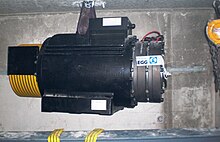Elevator machine
Elevator machines are used to drive traction sheave and drum elevators . They consist of an electric motor , usually a gearbox , one or two brakes and a cable drum or traction sheave .
history
In the early days of elevators in the late 19th century, steam engines were first used, but these were quickly replaced by electrification and electric motors. As hoisting machines in mines , however, steam engines were sometimes still in use until the late 20th century.
Engines
Special designs of three-phase synchronous and asynchronous motors are usually used for elevator machines. In systems with high heads and speeds were up to the advent of frequency converters and DC motors with Leonardsatz used. It was only with the introduction of frequency converters that it became possible to install standardized industrial motors in larger systems.
Standard motor
Single-stage standard motors were also installed in ordinary elevators in not too high residential buildings. To stop, the contactor switches off the motor current and the brake engages immediately. Loading, temperature and the condition of the brakes could easily lead to an inconsistent standstill in the station. Today such potential stumbling blocks are no longer allowed.
2-winding motor

In order to reduce the jerk when starting and especially when braking and still achieve a high travel speed without complex control technology, asynchronous motors with two windings with different number of pole pairs were developed. This achieves a high driving speed on the one hand and a low approach and retraction speed on the other hand. In addition, a flush stop in the station is easier to manage. The windings are switched one after the other via two contactors . The still unavoidable jolt when switching on or off is further reduced by a flywheel .
This type of motor was the most widespread until the introduction of frequency-controlled drives, but is no longer built. Thanks to its robust and simple design, it is extremely durable, so when modernizing it is often retrofitted with a frequency converter (on the "fast" winding). This type of motor was used in elevator systems at speeds of around 1.5 m / s.
DC motor
DC motors were used at higher speeds when control via the 2-winding motor was not sufficient. The circuit and control engineering effort and the space requirement was, however, many times higher due to the required Leonard sentence . The maintenance effort and energy consumption were also significantly greater.
Permanent magnet excited, frequency controlled synchronous motors
Permanent magnet excited, frequency-controlled synchronous motors represent the most modern design for elevator motors. They achieve enormous torques at very low speeds (typically around 100 / min), so that an additional gear can be dispensed with. This results in almost noiseless operation and very little maintenance. Extremely strong permanent magnets are arranged on its rotor , and up to 32 pole pairs are wound on the stator . The maximum frequency is so far below 50 Hz that these motors can only be operated with special frequency converters.
transmission
Various types of gears are used to make the high speed and low torque of asynchronous motors available for elevator operation. By using particularly small traction sheaves with belts or very thin ropes, asynchronous motors without gears can also be used in some modern elevators.
Worm gear
Due to the very high gear ratio in one stage, their compact design and the - depending on the gear more or less - high self-locking - worm gears represent the most and longest used elevator gear . They are available in all sizes for all payload ranges. Until the 1980s, they were set up separately from the engines on base frames or foundations, and the two units were connected to one another by a shaft coupling. In the meantime, the integrated design, in which the motor is flanged directly to the gearbox housing, has established itself. This design offers advantages during assembly, since the motor and transmission no longer have to be aligned with one another. Another advantage is that the machine foundation can no longer cause shaft distortion between the motor and the gearbox. The three-point bearing of the traction sheave shaft is now considered obsolete, as the permanent alternating load of an incorrectly mounted shaft occasionally breaks the shaft and, as a result, causes it to crash upwards .
Planetary gear
Planetary gears are rarely used because of their complicated structure. Due to its high acquisition costs and the noise development, which increases sharply with the wear and tear of the gearwheels , this type of gearbox only plays an outsider role despite its high efficiency.
V-belt drive
V-belt drives represent another type of construction. Their advantages are the very simple structure, the smooth running, oil-free operation, and their easy maintenance and repair. The disadvantages are the relatively complex and time-consuming assembly, the high space requirement and the limited service life of five to ten years for the V-belt. V-belt drives were introduced in the 1960s, but are currently no longer built.
Other types
Various manufacturers have tried to establish other, in some cases very exotic, variants of gearboxes on the market. However, they did not gain acceptance, as the frequency-controlled direct drives achieved the lowest possible energy consumption and assembly costs on the one hand, and the best driving characteristics and lowest investment costs on the other.
Brakes
Similar to automobiles, drum brakes were the only way to bring the elevator to a stop at the end of the journey in the early days . With the appearance of direct drives and integrated gear motors, disc brakes were increasingly used. All brakes have always been released by electromagnets , the braking force is achieved by spring force. For a long time, a single brake was enough to slow down the system. However, numerous accidents caused by brake failure led to the introduction of the dual-circuit brake, in which two independent, fully-fledged brakes significantly increase the safety of the elevator system.



